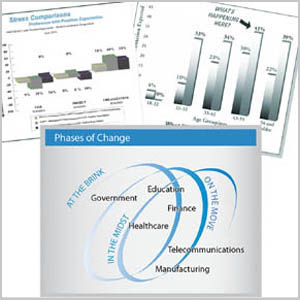What is WSP™ Alignment For You, Others and Your Work
WSP™ Alignment is all about fit! We know fit when we experience it – it just feels good. We know when we find the right sized clothes, it just feels right. It is the same with work – finding the type of work that fits us to do our best work just feels good. The challenge is finding the work that best fits. We call this match WSP™ Alignment – the degree of alignment between how you like to work and how the work is required to be done. How you like to work is your Preferred WorkStyle Profile, the WANT. How you perceive your current or prior work is called your Position Actual Profile, the IS.
These two assessments within the WSP™ Inventory compare the degree to which the two Profiles align with each other, showing the degree to which you have WorkStyle Alignment Fit or misalignment = WorkStyle Stress. Throughout your report you will see WSP™ Graphs in a variety of ways, serving as a visual roadmap – such as Preference to Position Actual comparisons, WorkStyle Stress, for Levels of Alignment Misalignment and WorkStyle Fit Analytics.

Preferred WorkStyle
Your responses to the statements in the WSP™ Inventory of how you like to work generates your Preferred WorkStyle Profile. This Profile contains valuable insights about how you like to contribute through your work – for problem solving, accountability, work communication, pride and more. It can help you find the types of work that give you the greatest satisfaction.

Position Actual WorkStyle
Your responses to the statements In the WSP™ Inventory of how you perceive yourself actually working generates your Position Actual WorkStyle Profile. This Profile contains valuable insights about how your work environment needs you to work in terms of contributions – problem solving, accountability, communication, pride, and more. This can help you understand what is required in your work for the best work environment results.

Degree of Alignment
Comparing how you like to work with the requirements of the work you are performing indicates the degree of alignment or misalignment you have in your work – how good the fit may or may not be. Looked at this way, discussions about work fit often are a relief as they provide an understanding of and framework in the language of work so changes can be made on a more objective basis, both for you and the work environment.
How Does WSP™ Alignment Help
You can use WSP™ Alignment information in a number of work environments and ways. We all work in various settings other than formal jobs – at home, in sports, at school and with volunteer activities. Understanding WSP™ alignment or misalignment provides a vital foundation for seeking opportunities and planning for future work goals.
WSP™ research has found that, in the absence of alignment planning and depending upon the degree of WorkStyle misalignment, people tend to demonstrate one of four unproductive responses to work stress. For example, you may experience low productivity and apathy, or you become irritable with frequent complaints. Another unproductive response is to absorb the stress to the point of having health issues without realizing it. Or you may change the work to experience more of your preference and thus impact the work environment and create performance issues. If you identify with any of these four responses, you are likely experiencing WorkStyle Stress.
If you discover through the WSP™ Inventory that you have WorkStyle misalignment – WorkStyle Stress – you now know why you are feeling the way you do. At one end of the alignment scale, you may have a large degree of misalignment. Use this as a sign that “things need to change” and use the Action Strategies in your WSP™ Inventory to make a plan for yourself and your place of work. At the comfort end of the alignment scale, ask yourself if there are small adjustments you and your place of work can make that would give you more of the activities you most enjoy performing. With this information, you can consider how to make changes in your work to gain a closer alignment and avoid the unproductive responses.
Students entering the workforce and those seeking work opportunities benefit from a much sharper focus in their search based upon what they have learned about WorkStyle alignment. They are able to use their WSP™ experience and knowledge to:
- Identity types of workplaces, professions, and positions for a good work fit
- Reduce the risk of being in the wrong job
- Make job search efforts more effective
- Use Preferred WorkStyle work examples in interviews
- Identify professions and skills of interest
Individuals in the workplace find that once they experience WorkStyle Alignment, they are:
- More productive and connected to the work environment’s purpose and goals
- Happier and more fulfilled with their work
- Healthier due to a better work/life balance
- Less likely to experience work conflicts and work stress
42 years of making a difference through workforce and workplace alignment

Research & Validity
Four decades of premier WorkStyle Patterns® (WSP™) research measures Positions and Patterns of People in Organizations throughout the global workplace. It offers a measurement component with validated analytics to provide an aggregate and comprehensive view of workplace and workforce dynamics. The WSP™ comparative research service is a major information source for current and future work trends.
The WorkStyle Patterns® (WSP™) Inventory has its origins in the mid-1970’s during which The McFletcher Corporation was responding to requests to help people with technical assignments shift to team and leadership roles. In McFletcher’s effort to identify a solution to this workplace shift, authors Tomas and Donna McIntosh-Fletcher developed the WorkStyle Patterns® (WSP™) concept – “Positions and Patterns of People in Organizations.”
They then further applied this concept by creating the original WSP™ Inventory to provide a means for members of the workforce to more fully identify and meet both their personal work preferences and their work environment’s requirements. This WSP™ Inventory was initially tested and re-tested with more than 5,000 direct employees, supervisors, and managers from a cross-section of organizations in the U.S, Mexico and Canada. The Inventory activity statements and responses were written and analyzed over a period of four years during the test and retest phase.
Construct validity tests and research were then commissioned through the Department of Educational Testing at New Mexico State University with resource staff from Arizona State University and testing services through Stanford University. During which Analysis of Variance and Levels of Significance tests were conducted. The results attributed to the WSP™ Inventory revealed a solid psychometric foundation with a highly significant construct validity rating. Dr. Douglas Muller of New Mexico State University led the construct validity project team. In their report, they wrote that, “…the WSP™ (is) the most objective data (we) have reviewed in the organizational development literature related to employee preference assessment procedures.” The author’s additional perspective for operational validity, in regard to usefulness, is when the results lead to greater personal fulfillment for the workforce and increased productivity outcomes for the workplace. This has been proven by thousands of individuals and hundreds of organizations worldwide.
Since the initial WSP™ Inventory testing, pre- and post-test studies with control and test group comparisons have been applied throughout the global workplace. Profile descriptions for people’s Preferred and required Position Actual WorkStyles were developed from score set findings to ensure practical information and guidance was included within the WSP™ Inventory. Levels of WorkStyle Stress due to gaps between Preference and Position Actual score sets – WorkStyle Alignment /Misalignment – were also identified for action planning purposes.
Companion WSP™ Inventories and alignment products have continued to be developed and supported by more than four decades of WSP™ Database research providing cutting edge knowledge of workforce and workplace trends across countries and cultures.

Analytics
The WorkStyle Patterns® (WSP™) Database provides comprehensive analytics highlighting WSP™ Inventory results to maximize the alignment of people, positions, organizations and markets. Studies are performed for specific work environment issues that impact the alignment or misalignment of peoples’ preferences and work environment requirements.
WSP™ normative data comparisons, such as by locations, profit centers, and/or regions, along with industry or profession distinctions are included with analytic recommendations for appropriate actions. Client-specific audits also identify cultural distinctions in preferences and work perceptions within multi-cultural environments. Reports with study highlights and key points include presentation resources in summary form of key results, issues, and resolutions suggestions.
Global workplace trends identified through WSP™ research and analyses are published periodically in WorkStyle Patterns® (WSP™) Briefs and Technical Reports, such as The Workplace and Boomers Divide. These highlight significant patterns in how work is being restructured in the ever-evolving information society. Click on the link to view these and many more in the Other Products section of this website.
WorkStyle Fit – a special analytics feature matches a person with workplace opportunities by:
- Types of work – Professions and Positions
- Interfaces of work – Professional, Support, Sales and Leadership roles and
- Places of work – Work Environments and Industries.
Within the WSP™ Inventory results, WorkStyle Fit options provide access to this feature with the WSP™ research-based listing of workplace opportunities. These options are dynamically correlated to positions being performed in the workplace that match each person’s Preferred WorkStyle Profile.
If you have yet to experience the WSP™ Inventory, Get Started Now for your own personalized listing of workplace options – your WorkStyle Fit!
